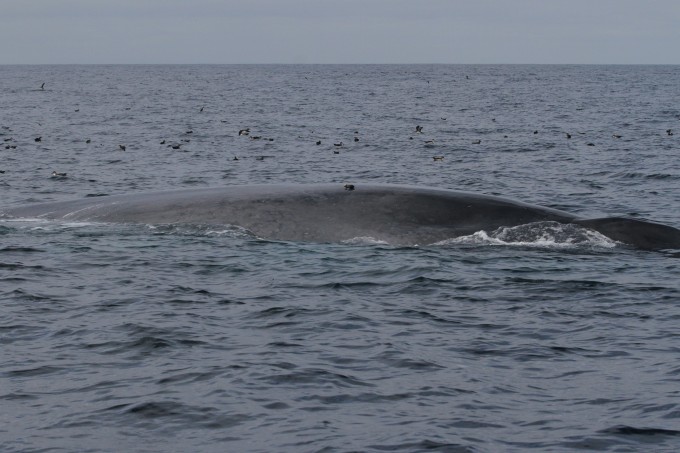After a few rough weather days – hot and windy with high seas – we got a break on our last day for this phase of SOCAL-14. It was nice and calm as we worked back towards our end point near LA and we found a number of different animals feeding on some rich aggregations of krill near the oil rigs in the San Pedro Channel – sea lions, dolphins, birds, fish, and minke, humpback, and blue whales. We managed to get two blue whales in the same group tagged simultaneously and follow them for most of the day tracking their movements, behavior, and calling as well. One of these blue whales (a large female who was the lead animal in this pair shown below – taken under NMFS permit #14534, credit J. Calambokidis).

We completed a successful experimental sequence with both whales who continued feeding, although it was halted slightly early when a sea lion swam close enough to the sound source that we had to terminate the experiment because of our permit mitigation requirements. Sea lions especially seem to be quite unaffected by and possibly even attracted to the sound source we use, which is an interesting observation even though they are not the direct subjects.

We have an incredibly talented and dedicated group of professionals on this project. We cover a lot of water in sometimes rough seas and work with some of the most challenging animals on earth to study. We have tagged 18 animals of 4 different species with 21 tags of 3 types and conducted 10 complete experimental sequences in SOCAL-14 thusfar. The breadth and amount of new knowledge, publications, and guidance for management decisions regarding the conservation and protection of marine mammals that has come from this project is entirely the result of this remarkable team. Many of them are shown in the photo below and we encourage you to check out more of what many of these folks do outside of the BRS project by linking to some of the websites of all our partners (notably www.cascadiaresearch.org, but see the many other partners listed on www.socal-brs.org and the partner links on the right hand side). We also want to acknowledge the support, cooperation, and willingness to ask hard questions by our sponsors at the U.S. Navy’s Living Marine Resources Program and the Office of Naval Research and our partners in various parts of the Navy. We have a two month hiatus until a final phase of SOCAL-14 in November. Thanks so much to those of you that have and continue to follow the blog and send feedback and questions.
